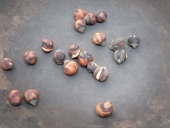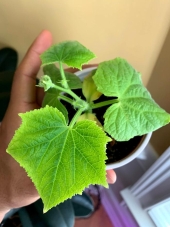My chickens always act like they're starving. I've read out on the webs that chickens generally eat 3-4oz/day (of mash, and I think that assumes that's their main intake).
They don't free range; they're in a run that's about 600 sq feet at a time, and which moves every couple-few weeks. Right now the grass is dry and there's not much self-forage.
I'm feeding my 13 chickens (12 right around 5mos old plus 1 adult hen) an organic mixture of grains/legumes (shifting from grower, 15% protein - to layer 20%; right now I'm mixing them around 50/50). I ferment it, b/c in theory that's supposed to improve bioavailability and help them eat less (which I don't see, though I generally only ferment for 1 day, sometimes 2, if that's relevant). I don't leave food "out" all the time, so nobody else (e.g. rodents) is eating it, and they always finish it. I feed them several pounds/day of produce from my garden (the grass in their run is brown since no rain, so that doesn't contribute much). They can dig around for bugs, although with the exception of 1 or 2 of them, they are generally not super fond of worms (annoying!).
SO, my question. It SEEMS like given how much produce I give them (currently apples, shredded zucchini, kale/broccoli leaves), and that I ferment their feed, I should be able to give them noticeably less than 4oz each per day. When I tried 2.25 pounds total (2.75 oz/bird), because of the large quantity of produce (and also I had a half gallon of expired milk that I fed them over those three days to supplement protein), they "acted" like they were starving. They certainly weren't, they just ate frantically when I dished it out. So I bumped that back up to 3.25 oz/bird, and they still act quite hungry (eating super way fast when I show up with food). So I've shifted that back up to 3.75 oz/bird, which they still finish readily, but they act less panicked about it. It just *seems* like so much, based on how much other food they're getting. I realize the produce is less calorie-dense. Is it really just barely impactful?
I'm working on building a compost pile for the run they're about to move to. The last one, in their prior location, wasn't broken down enough to be providing lots of bugs before I moved them, so I do not have this angle dialed in yet...
Besides wishing I could keep feeding (and thus per-egg) costs reasonable, what I'm really wanting is to reduce reliance on outside feed, I want to increase reliance on feed I can generate on my land (turning their beaks up at worms is not helpful). For the winter: I have maybe 80-90 starts of kales and mustards that I'll be growing as a chicken garden for winter-food (I'm zone 8, maritime PNW, so this should hopefully grow enough before it gets cold, and overwinter), plus I grew some extra winter squash to share with them.
How much feed would you think is necessary in this scenario?









